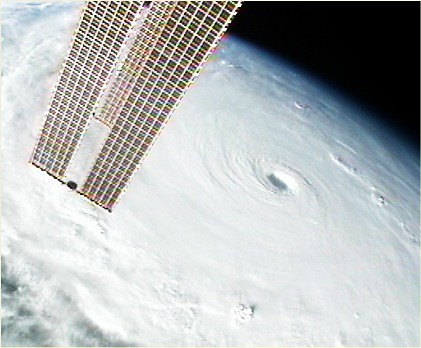 |
| Our planet |
We divide our planet into several different branches and tend to study them individually. However, even though we like to do that, we also know that different aspects of our planet tend to interact with each other in ways unimaginable. Such were the topics of some of the lectures given here.
One such talk that I found fascinating was given out by University of Wisconsin professor Jonathan Martin. It started up with a simple question. What does the October 2010 "bomb" storm, one of the most intense extratropical cyclones of all time, have in common with a western pacific super typhoon that went with the name of Megi? (pictures below)
 |
| October 2010 system. |
 |
| Super Typhoon Megi as seen by International Space Station. |
The story is not all too complicated. It starts off with the powerful typhoon moving to the northwest. As it moved poleward, it carried it's high-reaching clouds with it. The air in these clouds are much warmer than the surrounding air, as it was lifted from the very warm tropical boundary layer and warmed by the release of energy from condensation. This air began to interact with upper-tropospheric features. It caused a merger of the subtropical jet and the polar jet. Moreover, the warm tropical air caused the an increase in temperature gradient over the jet area. The end result was a monster jet that roared with incredibly strong winds.
 |
| Aside wreaking havoc to whatever it touched, what else can a typhoon be capable of? |
 |
| The warm air that caused the monster jet moved eastward, towards the US. This plot is obtained from Martins presentation, which can be found on his website. |
Now normally this would not be a big deal. Jets are high enough that, would they not interact with anything else, they might just be trouble to airplanes flying through it. But in our atmosphere this is not the case. Things interact with each other in very interesting ways. So when this jet reached the US, and closed in on a developing cyclone, trouble brewed. When the area of high winds moves around a trough it has large value of vorticity. This can enhance the deepening of extratropical cyclones, and this was the case. The end result was a record setting "bomb" that caused widespread damage over the U.S.
 |
| NOAA surface analysis depicting the impressive storm of Oct 26 2010. |
This was not the only talk that mentioned interesting interactions within the Earth System. Another scientist was mentioning the potential of deep convection in the tropics to affect signals in the ionosphere, and another one mentioned how you can see the signal of strong storms in seismographs and measure the effect of these in the rotation of the Earth.
This is just the tip of the iceberg when we talk about interactions. The talks about it have been numerous, and I've not been able to attend them all. It is truly amazing in the many ways the different features of our planet interacts, it can make anybody intimidated to tackle these problems. But it does give an interesting thought. No matter how many topics you divide the Earth Science into, you have to always remember that it is still just one Earth, our Earth. It is complex, yet beautiful; tough, yet frail. Any small change done to it can lead to major consequences somewhere else. This could be in a matter of days, or centuries.
With this said, do you think that our race, with over six billions individuals spread all over our planet, could potentially have an effect on the different aspects of our planet?

No comments:
Post a Comment